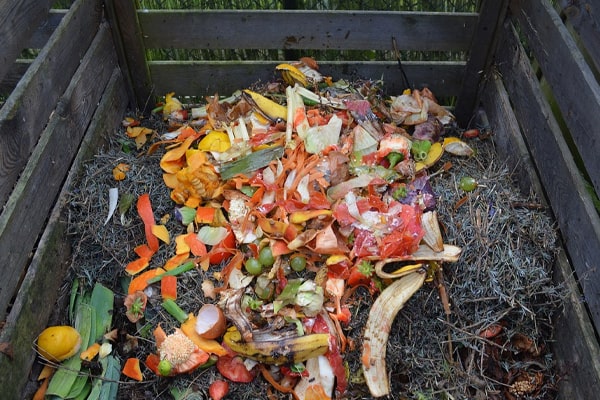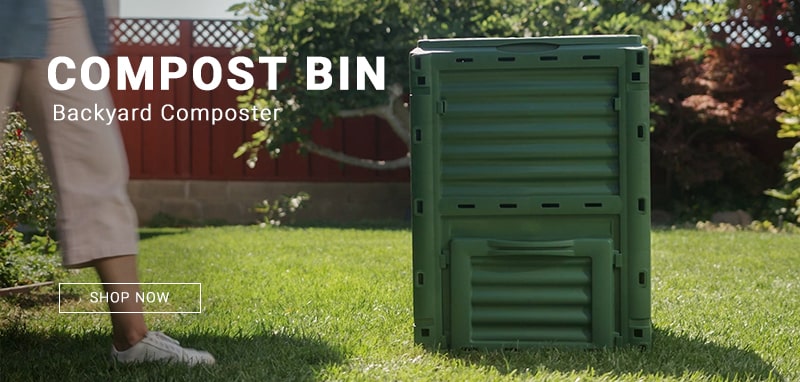Think of composting as upcycling your household wastes. You’re not just saving a lot of money on natural fertilizers; you’re also saving the environment. Composting at home also means supporting the complex yet delicate ecosystem in the garden to ensure a plentiful harvest or better blooms come spring and summer season! Composting starts by building your own outdoor compost bin. In this guide, let’s dive deep into composting, how to build an outdoor compost bin, what type of garden compost bin to get, and all the benefits of composting.
Contents []
Composting Basics?
Benefits of Composting
It’s eco-friendly: About 30% of the yard waste and kitchen scraps you throw away could be composted. Apart from minimizing the amount of garbage your family sends to landfills, composting your yard and kitchen wastes in a compost garden bin also reduces methane gas production.
You’ll save money: Who doesn’t want to save a lot of money on organic fertilizers? Let’s face it; organic fertilizers are expensive, especially if you have a large garden. Creating your own compost garden bin at home means you’re able to produce garden gold for free. You’ll throw the yard and kitchen wastes anyway, so why not use these to make something beneficial for the garden instead?
It’s easy: Anyone can compost at home; it’s so easy. All you need is a spot to set up a compost garden bin or a compost heap, and that’s it. As long as you have room in your garden for a compost bin, you are ready for composting. It’s just a matter of setting up the compost pile or bin.
Types of Compost Bins
Compost Pile, Compost Bin, or Compost Tumbler - Which One is Right For Me?
When it comes to composting at home, there are three ways to do it. You can create a simple compost pile, get a compost bin, or a tumbler compost bin. So which one is best for you?
Compost Pile
A compost pile is perhaps the simplest out of these methods. It's simply a heap of organic waste and vegetation that you leave to degrade on its own.
To create a compost heap, you'll need to check for a level, well-drained spot. This way, excess water won't collect and drown the microbes that break down the organic wastes.
One of the best things about creating a compost heap is that earthworms and beneficial critters have easy access to organic wastes. And when these critters are plentiful in a compost heap, the materials degrade quickly. This means, in no time at all, your compost will be ready to use.
The only downside is the odor and pest problems. You cannot use a compost heap in crowded areas because the foul smell will reach your neighbors. Also, burrowing rodents and small animals will be attracted to the smell. Apart from the odor problems, turning the compost pile is labor-intensive, and the heap will need a lot of brown waste; otherwise, the organic materials won't degrade properly.
If your outdoor space is small, a compost pile might not be the best way to go because it will require more space. A compost pile is best for a large outdoor area with only a few neighbors.

Compost Bin
This is composting using a container to hold the organic wastes. You can create the compost bin on your own using cinder blocks, wood, and other materials, or get a compost bin from your local garden store.
What's great about using a compost garden bin is that controlling air and moisture is easier. You need aerobic bacteria to thrive so organic materials are broken down efficiently. A compost bin provides the ideal environment for these beneficial microbes to thrive. In short, a compost bin speeds up the process of decomposition.
Because the compost is held in a bin, burrowing rodents, small animals, and other pests cannot get into the compost. Odor problems could be remedied by covering the bin with plastic sheets or getting a bin with a built-in cover.
The downside is that pests could get in quickly if the bin's cover isn't tightly closed. Also, some compost bins are not completely weatherproof, so be selective in terms of the materials used for outdoor compost bin. We suggest a compost bin with drainage holes so the soil could absorb excess water. Go for a compost bin that gives direct access to the ground.

Compost Tumbler
A compost tumbler is similar to a compost bin, except it’s set higher up. The tumbler compost has a handle on the side that you turn to rotate to mix the compost. And because of the regular turning, the compost heap won’t produce much odor. The sealed container typically has a cover to keep the compost sealed while being turned. It also features drainage holes so that excess water could drain away as you turn it.
While no doubt revolutionary, the design of a compost tumbler presents a few challenges. For one thing, since the bin is set higher than the ground, it’s not in contact with the soil, and earthworms cannot thrive. You can throw in a handful of earthworms but if the container is sealed shut, air cannot circulate properly.
Water may drain away, but the environment within the compost tumbler is not conducive to proper air circulation. The ideal air and moisture levels are hard to achieve because the container is sealed shut and water drains slowly.
Yes, it’s easy to turn the pile, but this too could prove problematic when you have filled the compost to the brim. A tumbler compost is small for a reason. Turning it will be harder when the load is too heavy. And speaking of load, a tumbler compost is not ideal for big compost because of the limited space. If you need a bigger compost container or you don’t want to keep emptying your compost bin frequently, a tumbler compost may not be the ideal solution for you.
Which Composting Bin is Right for Me?
Whatever compost bin you use, be sure that it suits the job perfectly. The bin should provide excellent air circulation and drainage for excess water. It should provide the ideal environment for beneficial microbes to thrive. It should also provide direct access to the soil.
Durability and size are also important. Choose a weatherproof compost bin that can withstand direct heat and water. It should be big enough to accommodate the amount of compost you need.
How to Compost at Home
Step 1: Collect the Organic Waste
Not all kitchen scraps are suitable for composting for different reasons. Meats and dairy products tend to attract pests and produce a foul odor when decayed. Oily residues tend to affect the microbes that break down the organic wastes. Pet wastes release pathogens that are harmful to plants and humans. We’ve listed down some of the best kitchen and yard scraps to compost in our Composting Guide for Beginners blog.
Step 2: Find a Good Spot for Composting
Most of us choose to set the compost bin outdoors, which makes the most sense to avoid potential odor problems. But, you can compost inside your home too. If you’ve chosen the former, be sure to set the compost bin outdoor in a spot that gets a lot of sun. Set your bin in a well-drained area so excess water won't pool into your compost bin and ruin the pile. Again, you can simply create a pit or get a compost bin.
Step 3: Add the Organic Wastes to the Compost Pile
No, don’t chuck the entire thing in one go. This has to be done gradually in layers. If you're simply throwing the organic wastes, the compost pile might not decompose quickly. Be sure that there is an equal layer of brown and green materials for balanced carbon and nitrogen levels. Also, shred the materials into small bits to speed up the decomposition process. Turn your compost pile at least once a week to aerate the pile, and that’s it. As long as you manage the compost well, it should be ready within 2 to 4 months.

Composting at home is so easy. As long as you have space for the compost pile/bin and you've got lots of yard and household waste, you can start composting right now. Found these tips helpful? Stick around because we’ve got more composting and gardening tips for you.



